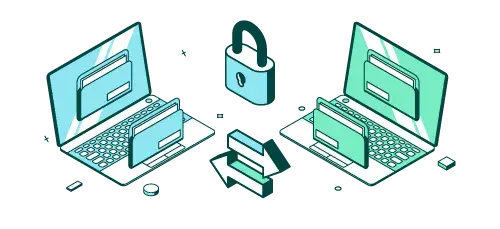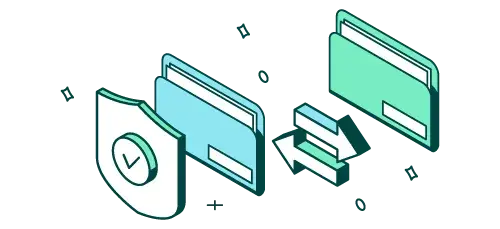What is Secure File Transfer?

Secure file transfer (SFT) is the process of how organizations can share their business-critical, often sensitive, data through a software solution, such as Managed File Transfer (MFT). By using encryption through industry standard network protocols, secure file transfer solutions ensure sensitive data is protected both in transit and at rest.
In addition to securing files in motion and at rest, a comprehensive, robust SFT solution should be able to:
- Be deployed in the cloud, on-premises, as a SaaS, or hybrid solution
- Audit or monitor all file transfer activity
- Help meet compliance requirements and data security laws and regulations
- Deliver automation features to help reduce human error and increase productivity
- Integrate with web applications already in use
What Does SFTP Stand For?
SFTP (Secure File Transfer Protocol) is not the same as SFT. Rather, it is a specific network protocol for securely transferring files between a client and server using SSH (Secure Shell) for authentication and encryption.
Secure File Transfer Protocol Options
HTTPS (Hypertext Transfer Protocol Secure)
This method encrypts any inbound web traffic and works to ensure data integrity and privacy.
SFTP (SSH File Transfer Protocol)
This is a solid option that can prevent unauthorized access while your sensitive data is in transit. SFTP requires authentication between the sender and receiver in order to access the data.
FTPS (File Transfer Protocol over SSL/TLS)
Much like the SFTP protocol, FTPS employs multi-factor authentication. It also offers two security modes to ensure sensitive information is protected during data sharing. This is a good choice for organizations needing to secure file transfers with trading partners and enterprise servers.
AS2, AS3, AS4 (Applicability Statements 2, 3, and 4)
Each of these are used for different types of file transfers.
- The AS2 protocol specification is used to transmit sensitive data securely and reliably over the internet. It supports the encryption of messages between trading partners and vendors via HTTPS, with data protected with digital certificates and encryption standards.
- With AS3, applications communicate information using the FTP protocol. AS3 provides a layer of security for data transmission through digital signatures and data encryption. AS3’s non-repudiation receipt (NPR) gives the sender legal proof of unaltered delivery and verification that the message received is identical to what was sent.
- AS4 builds on AS2’s foundations and is an open business-to-business (B2B) standard for securing and exchanging documents between businesses using web services. AS4 is frequently used for EDI integration projects, for both client and server (push pull actions) and is payload agnostic.
MFT (Managed File Transfer)
MFT should support any of the protocols above and ensure that files are secured internally and externally. A robust MFT solution, like Fortra’s GoAnywhere, offers centralization, encryption at rest and in transit, dashboard-style ease-of-use, automation features, and flexible deployment options. GoAnywhere offers a single pane of glass view of all file transfer activities for the transparency and accountability needed for industries accountable for compliance requirements.
Benefits of a Secure File Transfer Solution
In addition to technical features, organizations should consider the following benefits that are valuable when implementing secure file transfer software:
Enterprise Secure File Transfer Service Advantages
Enterprise secure file sharing is distinguished from free file transfer methods, or applications like Dropbox or Google Drive, by offering a higher level of control and automation over the file transfer process. An enterprise-level solution, like Fortra’s GoAnywhere MFT offers organizations seamless collaboration, integration with other applications, robust security, and administrative controls to protect the data being exchanged within and outside of the enterprise network. Free file transfer options simply can’t offer the level of security, automation, and ability to transfer large files of a secure, managed file transfer solution.
In addition, an enterprise-level secure data transfer service or solution can provide confirmation that a file was sent and received as intended, high-availability, clustering, and detailed auditing and reporting, as required for many compliance mandates.
A comprehensive data transfer solution delivers scalability, reliability, and responsive technical support. It should also provide notification if a transfer failed to deliver and if it was able to resume transfer where the transfer was dropped. Enterprise solutions are centralized and can quickly be ramped up to meet the needs of an organization now, and as it scales in scope.
The ability of MFT to apply automation to the process of transferring files can streamline the exchange of data over secure SFTP connections, boosting productivity and allowing enterprise teams to focus on higher-level priorities versus tedious manual file transfer processes. Multi-step projects can also be set to run without manual intervention, recurrent file transfers can be established, and all file transfer activity can be monitored, audited, and recorded to help meet compliance requirements.
Secure File Transfer Solutions
Managed file transfer solutions, such as GoAnywhere MFT, can support the following top secure data transfer methods:
- AS2 (Applicability Statement 2)
- AS3 (Applicability Statement 3)
- MFT (Managed File Transfer
- FTPS (FTP Secure)
- HTTPS (Hypertext Transfer Protocol Secure)
- SFTP (Secure File Transfer Protocol)
- SCP (Secure Copy Protocol)
Organizations have a number of choices when it comes to how they exchange data within and outside of their network securely. Whether you’re sending ad hoc email attachments containing sensitive information or exchanging thousands of business-critical files each day, the security surrounding your file data matters. Cybercrime increases each year and choosing the best secure file transfer service for your needs should be a high priority to avoid the costly impacts of a data breach.
Five Secure File Transfer Alternatives to FTP
Which Secure File Transfer Service is Best for You?
Choosing the best solution for the files your organization transfers each day – large, small, or batched -- requires a bit of homework upfront to ensure you’re making the right choice for your unique needs.
Whether you are transferring sensitive patient data, invoices, or other business-critical documents, you need to be sure your documents, emails, and databases are encrypted to limit the risk associated with an attack, breach, or user error.
You also need to consider your organization’s network and IT capabilities for achieving the higher level of protection needed and consider which of your options can help you meet any compliance requirements that may apply, such as HIPAA, PCI DSS, FISMA, and others.
A Few Considerations When Choosing the Best Secure Data Transfer Solution:
- Determine which environment you plan to integrate your secure file transfer solution in before you start your search. Ask questions about how a solution works in your chosen environment and check how difficult it may be to migrate if you start on-premises and later want to move to the cloud – or vice versa
- Keep industry-specific needs in mind when evaluating file transfer solutions to better vet what will and won’t work right away. For example, can your solution meet the healthcare industry’s requirement for auditing and reporting, or the banking and finance sector’s needs to secure data in transit and at rest to meet the Dodd-Frank Act compliance requirements? Each industry has unique needs so cross-checking your file transfer options to ensure they meet your needs is critical.
- How well does your file transfer solution defend against data breaches and cybercrime? Consider vendors’ security and data breach defenses. A few questions (there are more) to ask potential candidates:
- What types of encryption standards are supported?
- Can I segment my organization into multiple security zones?
- Can I define various permissions for separation of duties?
- Does this solution track all user events and file transfer activity?
- Is this solution able to integrate with malware applications to help ensure files received into your environment don’t contain viruses?
- What features are most critical for your organization? A robust file transfer solution should offer a comprehensive features selection. You may not need all of them at first, but as your use of secure file transfer increases in your organization, you’ll be happier knowing your software solution offers the features you need when scaling usage.

Features to look for:
- Auditing and reporting
- Acceleration
- Cloud support
- Remote agents
- Automation
- Data loss prevention (DLP) integration
- Extensive security controls
- Secure email
- Flexible web client
- Load balancing and clustering
How to Use Secure File Transfer
Step 1: Choose which SFT Method You Wish to Send File Through
You can confidently send sensitive files via Secure File Transfer (SFT), otherwise known as MFT or Managed File Transfer solutions. Whichever method you select, you can be assured the file is secure both in transit and at rest. Options include:
- Send the file through an SFT email plugin
- Send it through a web client (access to the SFT solution from a browser)
- Automatically send it directly through the secure file transfer workflow
- Place a file in a dedicated folder that the recipient can connect to securely for download
Step Two: Encrypt the File through SFT
After you send the file, upload it to your browser, or drop it in a monitored folder, the SFT solution receives the data and secures it. GoAnywhere MFT encrypts files using FIPS 140-2 compliance AES ciphers and includes the following encryption protocols:
- AS2, AS3, or AS4
- Open PGP
- ZIP with AES
- SFTP
- FTPS
- PeSIT
- HTTPS
Step Three: Schedule Transfers through SFT
Once data is encrypted, you can utilize SFT software such as GoAnywhere’s built-in scheduler to schedule and execute file transfers and projects or workflows at future dates and times. You can schedule projects to run on a one-time basis, or on any number of recurring frequencies (every minute, hour, day, certain days of the week, every month, etc.)
Step Four: Deliver Encrypted File to Recipient for Decryption
Once the encrypted SFT file transfer leaves your server, it's off to the recipient’s location you indicated – an email address, designated folder on another server, or other location. The authorized recipient then can access that file, decrypt it, and even translate it as needed.
Additional SFT Benefits with GoAnywhere MFT
- Robust auditing and reporting to store and track the audit details needed to meet compliance requirements.
- Automation and Advanced Workflows to help reduce the risks of human error and to streamline routine or repetitive tasks.
- Auto-retry connects and integrity checks to help guarantee delivery of SFT exchanges
- Flexible deployment on-premises, the cloud, SaaS or hybrid environments
- Integration with Threat Protection solutions to inspect content transferred with SFT for threats as well as leakage. Without the risk of malware or data loss, organizations can be confident data will be shared and received securely.
- Integration with SFT rights management to define and control who can access those encrypted files, no matter when or where they travel.
Get Your Ultimate Buyer's Guide
Our Ultimate Buyer’s Guide offers comprehensive considerations, including a handy vendor comparison checklist to help your organization make the best choice from among the choices in the secure file transfer marketplace.
GoAnywhere: Your Best Secure File Transfer Solutions
GoAnywhere delivers the features and benefits needed by today’s organizations to protect the priceless data exchanged within and outside of the organization each day. The solution is a simple but secure file transfer method that easily lets organizations create, schedule, monitor, and process files as they are sent or retrieved. Test GoAnywhere out in your own environment with a free trial. Or request a 15-, 30-, or 60-minute demonstration.